| Adapted for the Internet from: Why God Doesn't Exist |
| Density is what overturns a pyramid |
A population pyramid pits age against numbers. [1] By looking at one, you can instantly tell whether the population is young
or old, or whether the growth rate is increasing (Fig. 1). The older a population gets, the more it is guaranteed to decrease
because one phenomenon feeds on the other. The process is self-sustaining and exponential. The older a population, the
fewer children it has. A dearth of children, in turn, results in an older population. The dearth of children coupled with better
health and living conditions leads to a geologically swift aging of the population which leads to further declines in the birth
rate.
- ________________________________________________________________________________________
- Last modified 03/03/08
- Copyright © by Nila Gaede 2008
Fig. 4 Inversion superimposed on total population |
Fig. 1 The population pyramid overturns |
What we are witnessing today is the geologically swift overturning of the global population pyramid. An urban population
ages for several reasons, among them:
- a. Women stop procreating as a result of density, a consequence in turn of socio-
- economic reasons.
b. Adults enjoy better living conditions and access to health services. Therefore, the
- majority of individuals live up to their natural life spans. In the past, this wasn’t
possible because disease and poor living conditions cut life short.
c. The reproductive age bracket is squeezed from two sides (Figs. 1 and 3). The
- average age of first pregnancy rises as women postpone having families until
they can afford children or until they can fit them in their busy schedules. As the
population increases and becomes older, women in the reproductive age bracket
become a smaller percentage of the population. Since individuals have fewer
children, the average age at which they have their last child decreases. Agrarian
women died young and on the average had children towards the end of their lives.
Urban women live twice as long and end up having children somewhere near the
middle of their lives.
These factors have led the average age of the world population to increase dramatically in the last couple of decades and
promises to continue doing so in the very near future. Demographers have estimated that at the start of the Christian era the
average age of the world population was probably around 16. There were relatively few old people and lots of young people.
Many children died before reaching puberty. This level changed little over the next few centuries. By the year 2000, however,
the average age of the world population was around 27. This average is expected to climb to 40 in just three or four decades
(Fig. 2). Best 71 offers a parallel trend: longevity. He tells us that life expectancy in the Roman Empire was about 22. By 1800,
it had climbed to about 40. Today it is closer to 80. These statistics indicate that the pyramid is overturning rapidly in
geological terms (Fig. 3).
| A population pyramid depicts the population mix. It pits young versus old and males versus females. A young population is characterized by a pyramid with a broad base and thin apex. This is the case of tiny, agrarian populations of which a good example is the Greek city state. An old population has a narrow base and a broad apex. This is the case with Man today. In new species, the population rises and most individuals are below the reproductive age bracket. In old species, population declines and most individuals are above the reproductive age bracket. |
| In the 19th Century, most people still lived in rural areas and the population was young. Late in the 20th Century, Man became an urban species (we nucleated in cities and abandoned the land to agri-corporations). The average age of the population has risen dramatically and will continue to do so as women stop procreating. Our species will soon attain ZPG and, subsequently, we can expect population to decline. Unless we can stimulate fertility again, this leads to extinction. What will get us to jump- start birthing again? |
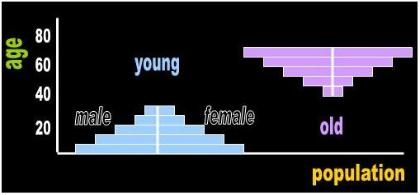
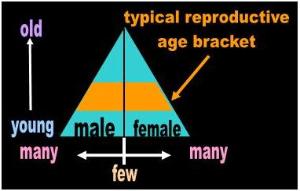

| The Pharaoh would probably never believe what became of it! |
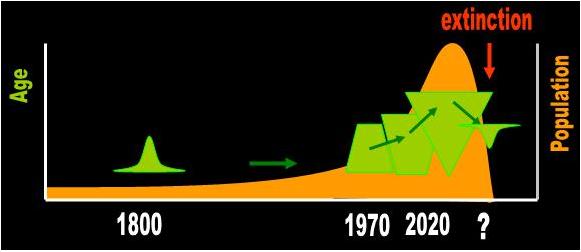
Fig. 2 Background extinction: The population pyramid overturns |
| A young population is characterized by a broad base and a narrow apex. As fertility drops and longevity increases, the population mix suffers a transformation. Gradually, there are ever older people and fewer young. This leads to a population pyramid overturn, in part, because the reproductive age bracket is compressed in relation to global population. It is unlikely that the reproductive age bracket remains constant throughout the lifetime of a species, but, because population increases swiftly towards the end of its life cycle, it is impossible for the age bracket to rise significantly in such a short geological period of time to make any difference. |
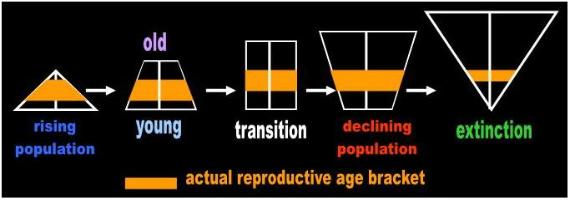
| In the past, the global population was quite young. It is estimated that the average age in the Roman Empire hovered around 16 or 17. In the year 2000, this number climbed to 27, and in only 30 or 40 more years it is expected to jump dramatically to 40 |
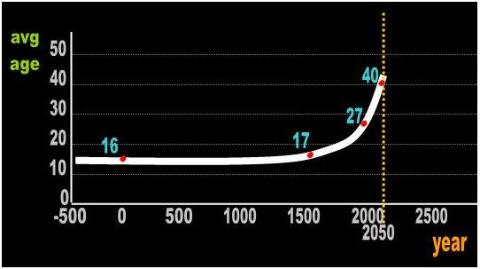
- Module main page: The mechanism behind background extinctions
Pages in this module:
- 1. The three population curves
2. All species eventually conquer the invisible bugs that keep their numbers back
3. Not education, but urbanization causes infertility
4. Urban women have no freedom to choose whether to have a baby
5. An urban woman doesn't have the privilege or need to have a family
6. This page: Density is what overturns a pyramid
7. Urbanization was inevitable
The first question the rise in average age raises is whether urbanization, which is responsible for pyramid inversion, was
inevitable. The second question is whether the most intelligent of species can find a way to reverse this process if
necessary… because if we can’t, it will necessarily lead to the extinction of our species (Fig. 4)!
